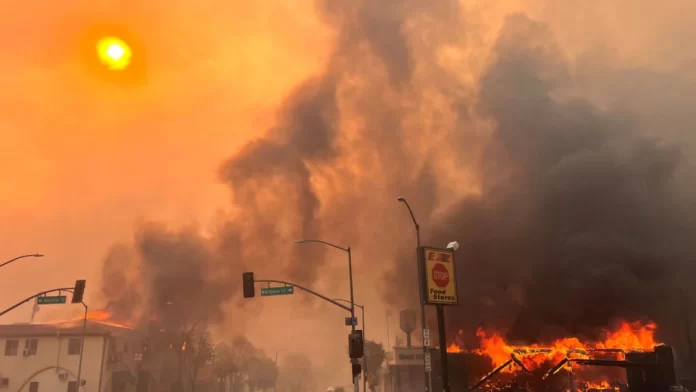With the recent wildfires, how can I check the current air quality in Southern California? What precautions should I take to protect my health during these conditions?.
Table of Contents
Toggle1. Introduction: The Growing Concern of Wildfire Smoke
Wildfires have become a recurring threat in Southern California, leading to dangerous air quality levels that can impact respiratory health. Smoke from wildfires contains fine particulate matter (PM2.5), toxic gases, and other pollutants that pose serious health risks, especially for children, the elderly, and individuals with preexisting conditions. Knowing how to monitor air quality and take the right precautions can help minimize exposure and protect your health.
2. How to Check Current Air Quality in Southern California
Monitoring air quality is essential during wildfire season. Fortunately, several reliable resources provide real-time updates:
A. Government and Environmental Agencies
- AirNow (www.airnow.gov) – Run by the U.S. Environmental Protection Agency (EPA), this website provides up-to-date Air Quality Index (AQI) reports, including wildfire smoke maps.
- South Coast Air Quality Management District (www.aqmd.gov) – Focuses on air quality monitoring in the Southern California region and issues health advisories.
- California Air Resources Board (www.arb.ca.gov) – Offers state-wide air quality reports and wildfire response guidelines.
B. Mobile Apps for On-the-Go Monitoring
- AirVisual (IQAir App) – Provides hyper-local AQI updates with color-coded alerts.
- Plume Labs: Air Report – Offers real-time pollution levels and forecasts.
- PurpleAir (www.purpleair.com) – Uses a network of low-cost sensors to provide detailed air quality reports at a neighborhood level.
C. Local News and Weather Reports
Many news outlets, such as ABC7 Los Angeles, NBC Los Angeles, and The Weather Channel, provide air quality updates during wildfire events. Checking these sources can help you stay informed about changing conditions.
3. Understanding the Air Quality Index (AQI)
The AQI is a standardized system used to measure air pollution levels. Here’s what the numbers mean:
- 0-50 (Good) – Air quality is safe for all individuals.
- 51-100 (Moderate) – Acceptable, but sensitive groups should be cautious.
- 101-150 (Unhealthy for Sensitive Groups) – Children, elderly individuals, and people with respiratory issues should limit outdoor activities.
- 151-200 (Unhealthy) – General population may experience health effects; avoid prolonged exposure.
- 201-300 (Very Unhealthy) – Everyone should stay indoors and use air filtration if possible.
- 301+ (Hazardous) – Emergency conditions; everyone should avoid outdoor exposure.
4. Health Risks of Wildfire Smoke Exposure
Wildfire smoke contains harmful pollutants that can affect lung and heart health. Common symptoms of smoke exposure include:
- Shortness of breath
- Coughing and throat irritation
- Headaches and dizziness
- Worsening of asthma or other respiratory conditions
Long-term exposure can increase the risk of cardiovascular diseases, lung damage, and reduced immune function.
5. Essential Precautions to Protect Your Health
If wildfire smoke is affecting air quality in your area, take these precautions to stay safe:
A. Stay Indoors and Keep Air Clean
- Close windows and doors to prevent smoke from entering.
- Use an air purifier with a HEPA filter to reduce indoor pollution.
- Set your air conditioner to recirculate air instead of bringing in outside air.
B. Wear Protective Masks When Outdoors
- Standard cloth masks do not filter out fine particulate matter (PM2.5).
- Use N95 or P100 masks for better protection against wildfire smoke.
- Avoid strenuous outdoor activities when AQI levels are above 100.
C. Stay Hydrated and Monitor Health Symptoms
- Drink plenty of water to help flush toxins from your body.
- If you have asthma or other respiratory conditions, keep medications accessible.
- Seek medical attention if you experience difficulty breathing, chest pain, or severe headaches.
6. Preparing for Future Wildfire Events
Wildfires are unpredictable, but being prepared can reduce health risks:
- Create an emergency kit with masks, medications, bottled water, and a battery-powered air purifier.
- Sign up for alerts from local authorities to receive evacuation notices and air quality warnings.
- Have a plan for relocating to a cleaner air environment if conditions become hazardous.
7. Stay Informed and Stay Safe
With wildfires becoming more frequent, monitoring air quality and taking protective measures is essential for staying healthy. By using reliable air quality tracking tools, wearing proper masks, and keeping indoor air clean, you can minimize the risks associated with wildfire smoke and protect yourself and your family. Stay prepared, stay informed, and prioritize your health during wildfire season.








